- Home
- Editorial
- News
- Practice Guidelines
- Anesthesiology Guidelines
- Cancer Guidelines
- Cardiac Sciences Guidelines
- Critical Care Guidelines
- Dentistry Guidelines
- Dermatology Guidelines
- Diabetes and Endo Guidelines
- Diagnostics Guidelines
- ENT Guidelines
- Featured Practice Guidelines
- Gastroenterology Guidelines
- Geriatrics Guidelines
- Medicine Guidelines
- Nephrology Guidelines
- Neurosciences Guidelines
- Obs and Gynae Guidelines
- Ophthalmology Guidelines
- Orthopaedics Guidelines
- Paediatrics Guidelines
- Psychiatry Guidelines
- Pulmonology Guidelines
- Radiology Guidelines
- Surgery Guidelines
- Urology Guidelines
Findings Do Not Support Steroid Injections for Knee Osteoarthritis: JAMA Study

Among patients with knee osteoarthritis, an injection of a corticosteroid every three months over two years resulted in significantly greater cartilage volume loss and no significant difference in knee pain compared to patients who received a placebo injection, according to a study published by JAMA.
Symptomatic knee osteoarthritis was estimated to affect more than 9 million individuals in the United States in 2005 and is a leading cause of disability and medical costs. Treatments for osteoarthritis are primarily prescribed to reduce symptoms, with no interventions known to influence structural progression. Synovitis (inflammation of a membrane that lines the joints) is common and is associated with progression of structural characteristics of knee osteoarthritis. Intra-articular corticosteroids (an injection in the joint) could reduce cartilage damage associated with synovitis but might have adverse effects on cartilage and bone.
Timothy E. McAlindon, D.M., M.P.H., of Tufts Medical Center, Boston, and colleagues randomly assigned 140 patients with symptomatic knee osteoarthritis with features of synovitis to injections in the joint with the corticosteroid triamcinolone (n = 70) or saline (n = 70) every 12 weeks for two years. The researchers found that injections with triamcinolone resulted in significantly greater cartilage volume loss than did saline (average change in cartilage thickness of -0.21 mm vs -0.10 mm) and no significant difference on measures of pain. The saline group had three treatment-related adverse events compared with five in the triamcinolone group.
Several limitations of the study are noted in the article, including that any transient benefit on pain ending within the 3-month period between each injection could have been missed by methods used in the study.
“These findings do not support this treatment for patients with symptomatic knee osteoarthritis,” the authors write.

Disclaimer: This site is primarily intended for healthcare professionals. Any content/information on this website does not replace the advice of medical and/or health professionals and should not be construed as medical/diagnostic advice/endorsement or prescription. Use of this site is subject to our terms of use, privacy policy, advertisement policy. © 2020 Minerva Medical Treatment Pvt Ltd